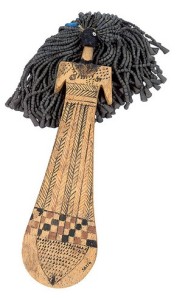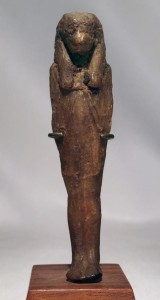As with so many things in Egyptology, there’s controversy surrounding the many female figurines that have been found throughout Egypt and spanning its long history.
These figurines take several forms. Some are standing females, usually nude with sexual characteristics emphasized (eyes, breasts, vulva). Some are abstracted into what have been called “paddle dolls”; more on them shortly. Some show a woman lying on a bed, often with a baby or child beside her. Others show a woman nursing a child.
The old gentlemen of early Egyptology initially guessed that the nude females and paddle dolls—some of them found in tombs—were “spirit concubines” for deceased Egyptian men. Because of course they did. However, the fact that they have been found in the tombs of women and children, too, throws a significant monkey wrench into that interpretation.
There’s also the more modern controversy about whether ancient female figurines should be interpreted as images of Goddesses or even as representations of an all-encompassing Mother Goddess. In opposition are those who regard the figures as devoid of divinity altogether and more likely to have been toys, ancestor figures, tools for sex instruction, or as mentioned above, the ever-popular post mortum concubines.
While the idea of a singular worldwide Goddess cult goes farther than strict interpretation of the evidence can take us (and, in fact, that is not what most proponents of the Goddess interpretation claim), the virulence of the opposition makes me question its objectivity as well. The truth is, we just don’t know. We have no ancient texts explaining these figures for us. Yet, at the very least, the ubiquity of the female figurines as well as their greater numbers in comparison to extant male figurines indicates a keen interest in the feminine by our ancient siblings.
Female figurines in Egypt
These images are also commonly interpreted as general “fertility symbols.” This makes sense due to the emphasized sexual characteristics of many figurines and the connection with the child in others, as well as the fact that a number of them seem to have been given as votive offerings to the Great Goddess Hathor, one of Whose concerns is fertility. Hathor also received what one Egyptologist described as “basketsful” of clay phalluses.
Another cache of these images that has received study come from the temple precinct of the Great Mother Mut. Of the small handful of votive images that include inscriptions, all are requests for children. In addition to temples and tombs, these figures have also been found in ancient homes and in domestic shrine settings.
Many modern Egyptologists have come to the consensus that the female figurines are symbols of fertility in its the broadest sense, which includes the ideas of general health and well-being, rebirth and regeneration—in addition to concerns with human reproduction.
There are some other interesting ideas as well. One that I hadn’t come across before is the idea that the paddle dolls are related to a specific type of royal and sacred musicians and dancers.
Paddle dolls
Paddle dolls are flat images with truncated arms, no legs, an emphasized vulva, decorative painting on the body, big hair—and sometimes no head, just a large mop of beaded hair. (See more on the magical importance of Isis’ hair here.) They were first called paddle dolls because of the flat, paddle-like body shape and dolls because they were thought to be toys; some even looked to the archeologists like they had been played with by a child. The largest number of paddle dolls have been excavated from the cemeteries around Thebes in Egypt.
In a paper on the subject, Ellen F. Morris follows a variety of interesting lines of evidence to conclude that the paddle dolls were meant to be representations of the khener-women. Members of the khener were once thought to be part of the pharaoh’s harim, but now are understood to have been skilled and respected musicians and dancers.
Married women and men could also be part of a khener. The khener could be connected to the royal household, to temples of the Deities, and to mortuary temples. When associated with the temples, it seems reasonable to think of them as priest/esses of music and dance.
The story of the birth of the three kings told in the Westcar Papyrus indicates that the women of the khener might also serve as midwives. In this tale, Isis, Nephthys, Heqet, Meshkhenet, and Khumn are specifically said to be disguised as a khener when They deliver the three children of Reddjedet. By the time of the New Kingdom, we know that a khener was part of the worship of Isis.
On several of the paddle dolls and on a number of examples of the female figurines, cross-shaped marks were found on the upper body. Some researchers have correlated these cross marks to similar cross marks seen on the bodies of partially nude female mourners in some New Kingdom tomb paintings. In some of these, two of the mourners are specifically identified as Isis and Nephthys. Scholars have theorized that the partial nudity may refer to Isis’ use of Her arousing sexuality to help bring Osiris back to life. This strengthens the argument that at least some of the female figurines were tools of resurrection, imbued with the arousing power of Isis. This ability of the nude or partially nude figures to induce (male, heterosexual) arousal may hold a key to the reason why they may be considered fertility figures. For potency—in life or after life—the male must be aroused and the female must arouse him.
Magical images
There are other possible uses for these figurines as well. Some researchers have suggested that they were purposely generic so that they could be assigned magical roles as need be. Healing seems to have been a common use. We have a ritual text that instructs the sufferer to recite a particular spell “over a woman’s statue of clay.” The spell, in the Leiden Papyrus (3rd century CE), is to cure a bellyache. Once the spell is spoken, the papyrus says that “the affliction will be sent down from him into the Isis-statue until he is healed.” (Would you like that in Egyptian? It is repyt Iset, “a female image of Isis.”)
We also find images of Isis used in relation to healing from snakebite. A spell in the Turin Papyrus (First Intermediate Period) instructs the ritualist to use “this clay of Isis that has come forth from under the armpit of Selket” to ward off a snake. In this case the spellworker is to enclose a knife and a particular herb within the clay. We can’t be completely sure whether the “clay of Isis” was in the form of Isis or used to form an image of the Goddess. Some scholars think that it likely was in the form of the Goddess and that the spell in full should read “this clay figure of Isis.”
In addition to clay, magic workers also used beeswax to form their magical images. Figurines made of beeswax are known from the magical papyri and, in specific relation to Isis, from Diodorus Siculus (1.21, 5-6). He says that the Goddess used wax to create multiple figures of Osiris, which She then gave into the keeping of priests throughout Egypt so that Osiris could be buried in locations throughout the land and thus to be widely honored.
A number of the female figurines we’ve found are broken. Originally this was thought to have been accidental. Now scholars are more inclined to think the state is purposeful. Why? Well, if they were being used in healing spells like the one in which the bellyache “went down into” the Isis statue, then to keep the bellyache from returning, it would be reasonable to break the image, permanently obliterating the bellyache with it. Modern magic workers often do the same sort of thing. Once the magic is accomplished, the talisman is dismantled, de-charged, or destroyed.
One of the books I’ve been reading on this conjectures that, given Her role in healing and protection, many of the generic female images may have been used specifically as Isis figures. The image “became” Isis with the recitation of the spell. The crude fashioning of many of the images is to be explained by the fact that, in many cases, they were intended to be disposable. Once broken and disposed, the images were no longer Isis, but simply a container for the affliction.

Images of the nursing woman
The female figure of a woman nursing an infant is easily seen as Isis nursing Horus. Stephanie Budin argues, however, that we should not understand this specifically as Isis and Horus until the late New Kingdom. Before that time, the image reflected a variety of Divine Wet Nurses nourishing the king.
She also discusses the fascinating idea that images such as the nursing woman—as well as the other female figurines we have been discussing—might have been used to intensify magic and prayers. She refers to them as “potency figures.” (This idea is also discussed by Elizabeth Waraksa, who has studied these images from the Mut temple.) In other words, the images were a kind of magical battery that empowered the ritual.
I like this idea very much. It’s also excellent magical practice. Modern priest/ess magicians would call it adding “correspondences” to the rite. Colors, stones, herbs, and symbols that relate to the ritual purpose can be used to help the magic worker “tune in” to the divine powers that can assist in accomplishing the magic of the rite. In the case of the nursing woman images, our ancient Egyptian might be tuning in to the nurturing or protective powers of Isis.
Budin also suggests that, alternatively, the nursing-woman images (for example, the one now in Berlin pictured above) may have been used as prayer intensifiers when honoring Isis and Horus. In this case, the image would serve as an offering as well as a magical battery.
All of these are interesting ideas and each makes sense in certain contexts. To me, it seems likely that the answer is “all of the above.” Egypt was an image-intensive society. The images were probably used in a wide variety of ways, some of which we may have deduced, some of which, as yet, we have not.









